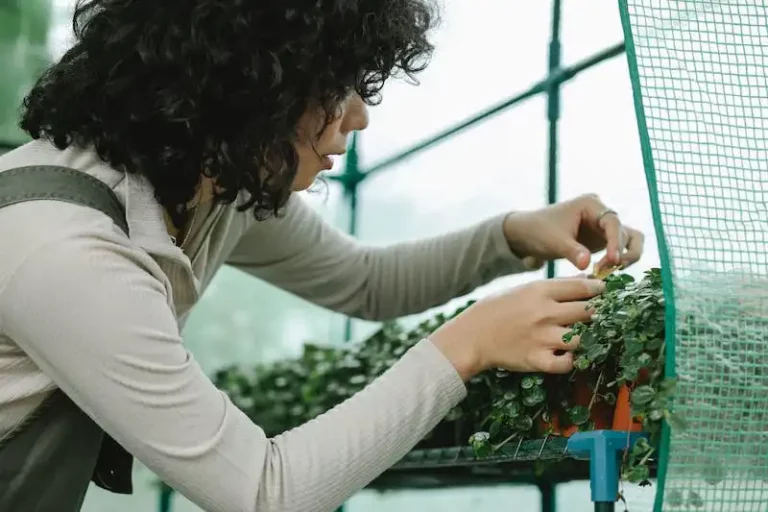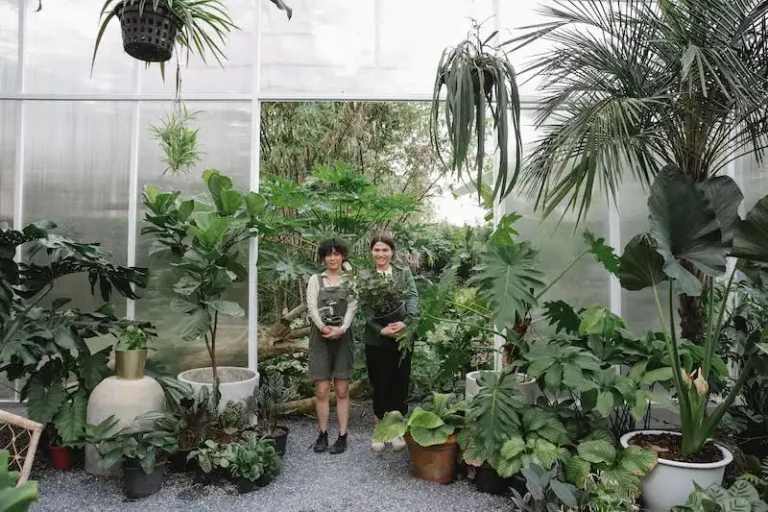If you are an avid gardener, Calathea ornata is a plant that should be on your radar. Known for its strikingly beautiful pattern of pink stripes on dark green leaves, this plant makes a bold statement wherever it is placed. Its unique appearance and easy care make it a popular choice for both beginners and experienced plant enthusiasts alike.
When it comes to calatheas, Calathea ornata is one of the most recommended varieties. Its eye-catching striped leaves are better at retaining moisture compared to other calatheas, making it an ideal choice for indoor gardeners who prefer a plant that goes the extra mile when it comes to humidity. With a quick glance, you’ll be able to tell that this prayer plant is something special.
Calathea ornata holds a lot of useful information about how it likes to be cared for. In general, it thrives in bright, indirect light, and prefers to be lightly fertilized. When it comes to watering, it is important to be mindful. These plants are sensitive to overwatering, so it’s better to keep the soil slightly moist rather than excessively wet. As for pruning, a simple trim here and there can help keep the plant looking its best.
If you’re looking to add a touch of elegance to your house or office, Calathea ornata is a great choice. Its ornate pattern and vibrant colors bring a tropical feel wherever it is placed. Whether it’s in a pot on the floor or in a hanging planter, this plant is sure to earn compliments from guests and colleagues alike.
Propagation of Calathea ornata can be done using the moss method. Simply place a stem cutting with a few leaves in a container filled with damp sphagnum moss, and give it time to develop roots. Once the roots are established, the cutting can be transplanted into a pot with well-draining soil to continue its growth.
In conclusion, Calathea ornata, also known as the pinstripe plant, is a stunning addition to any plant collection. Its unique pattern and sensitivity to light make it a show-stopper, while its easy care and tolerance for indoor conditions make it a favorite among plant enthusiasts of all experience levels. With a little attention and care, this gorgeous plant is sure to thrive in your home or office, bringing a touch of the tropics to your space.
Indoor Pinstripe Plant: Info Growing A Pinstripe Houseplant
The Pinstripe plant, scientifically known as Calathea ornata, is a popular indoor plant that is cherished for its striking appearance and easy care. If you’re looking to spruce up your indoor space with a unique and eye-catching plant, the Pinstripe plant might be the perfect choice for you.
Before we dive into the specifics of growing a Pinstripe houseplant, let’s take a closer look at some essential information about this plant.
- Plant Name: Calathea ornata
- Varieties: There are several Calathea ornata varieties available, each with slight differences in leaf pattern and color.
- Lighting: Pinstripe plants prefer bright, indirect light. They can tolerate low light conditions, but the colors on their leaves might become less vibrant.
- Temperature: Pinstripe plants thrive in temperatures between 65°F (18°C) to 75°F (24°C). They can handle slightly cooler temperatures, but avoid placing them in drafts or near cold windows.
- Watering: It’s important to keep the soil consistently moist but not soggy. They prefer slightly humid conditions, so misting the leaves occasionally can be beneficial.
- Fertilizer: Feed your Pinstripe plant with a balanced liquid fertilizer every month during the growing season (spring and summer), and reduce fertilization in the winter.
- Soil: Use a well-draining substrate that holds moisture but doesn’t become waterlogged. A mix of peat moss, perlite, and compost is suitable for Pinstripe plants.
- Pots: Choose a pot that’s slightly larger than the root ball of your Pinstripe plant to allow room for growth. Make sure the pot has drainage holes to prevent waterlogging.
- Pruning: Regularly inspect your plant for any dead or brown leaves and remove them promptly. Pruning also helps to maintain a compact and tidy appearance.
Now that you have the essential information, let’s address some common questions and potential problems that may arise when growing Pinstripe plants indoors.
- Why are the leaves curling? If the leaves of your Pinstripe plant are curling, it’s often a sign of low humidity. Increase humidity by misting the leaves or placing a tray of water near the plant to provide moisture.
- Why are the leaves turning brown? Browning leaves can be caused by underwatering, low humidity, or too much direct sunlight. Ensure you’re watering your plant adequately and providing sufficient humidity.
- Are Pinstripe plants toxic to dogs? Pinstripe plants are considered non-toxic to dogs. However, it’s always important to be cautious and keep an eye on your pets around any houseplants.
- What are the common diseases and pests? Pinstripe plants are susceptible to common houseplant pests such as spider mites and mealybugs. Keep an eye out for any signs of infestation and treat them promptly.
- Can I grow Pinstripe plants in a terrarium? Yes, Pinstripe plants can be grown in a terrarium. However, it’s essential to ensure adequate airflow and prevent the build-up of excess moisture, which can lead to root rot.
- Where can I buy a Pinstripe plant? You can find Pinstripe plants at local nurseries, plant shops, or online stores that specialize in houseplants.
Now that you have a comprehensive guide to growing an indoor Pinstripe plant, you’re well-equipped to care for and enjoy this unique and beautiful addition to your plant collection. Remember to regularly check for any issues and address them promptly to ensure the health and vitality of your Pinstripe plant.
Care for Pinstripe Plants
When it comes to caring for pinstripe plants, there are a few key factors to keep in mind. These beautiful plants, scientifically known as Calathea ornata, are often found in their native habitat on the forest floor of Brazil. They are highly sensitive to changes in their environment and can be a bit challenging to care for, but with the right knowledge and attention, you can help them thrive.
Light: Pinstripe plants prefer bright, indirect light, so placing them near a window where they can receive filtered sunlight is ideal. However, be cautious of direct sunlight as it can scorch the delicate leaves.
Temperature: Pinstripe plants like to be kept in temperatures between 60-75°F (16-24°C). Be sure to keep them away from drafts and avoid sudden temperature changes as this can stress the plant.
Watering: The watering process for pinstripe plants requires a delicate balance. It’s important to keep the soil evenly moist but not soggy. Water just enough to dampen the soil and then let it dry out slightly before watering again. These plants are sensitive to overwatering, so be cautious not to let them sit in standing water.
Humidity: Pinstripe plants prefer a humid environment, so if your home is on the dry side, you may need to provide some extra moisture. A good option is to place a small tray of water near the plant or use a humidifier.
Fertilization: Pinstripe plants don’t require frequent fertilization, but feeding them once a month during the growing season with a balanced houseplant fertilizer can help promote healthy growth.
Pests and Diseases: Pinstripe plants are generally resistant to pests, but keep an eye out for common houseplant insects like spider mites and mealybugs. If you notice any signs of pests or diseases, address the issue promptly by using the appropriate treatment.
Repotting: Pinstripe plants don’t appreciate being disturbed, so repotting should only be done when necessary. If the plant has become too large for its container or the soil has become compact, it may be time to repot. Choose a well-draining potting mix and only go up one pot size when repotting.
Overall, pinstripe plants are beautiful additions to any indoor space. With their striking pin-stripe pattern and unique foliage, they can really spruce up a room. Taking the time to care for them properly and providing the right conditions will ensure they stay healthy and continue to show off their gorgeous leaves.
If you have any questions about caring for your pinstripe plant or need more information, reach out to your local gardener or consult a comprehensive care guide. Happy gardening!
Calathea ornata: The Complete Guide to the Pinstripe Plant
If you’re a plant lover looking to add a touch of whimsy and elegance to your indoor green space, the Calathea ornata, also known as the Pinstripe Plant, is a fantastic choice. This guide will provide you with all the information you need to know to care for this stunning plant.
Potting: When potting your Calathea ornata, make sure to use a well-draining soil mix. This type of plant doesn’t like to sit in water, so ensuring proper drainage is key. Additionally, choose a pot that has drainage holes to prevent water from pooling at the bottom.
Watering: The key to keeping your Pinstripe Plant happy is to provide it with consistent moisture. Water regularly, allowing the soil to dry out slightly between waterings. Be sure to water evenly and avoid over-watering, as this can lead to root rot.
Light: Calathea ornata prefers bright, indirect light. While it can tolerate lower light conditions, it may not show its distinctive pinstripes as prominently. Avoid direct sunlight, as this can cause the leaves to burn.
Humidity: Calathea ornata is a tropical plant that thrives in high humidity environments. To increase humidity levels, you can mist the leaves with water daily or use a humidifier. Placing the plant on a pebble tray filled with water can also help to create a more humid microclimate around it.
Temperature: This variety of Calathea prefers temperatures between 65-85°F (18-29°C). It is important to keep the plant away from drafts or cold air, as this can cause leaf curling and other problems.
Pruning: While the Calathea ornata doesn’t require much pruning, it’s a good idea to remove any dead or yellowed leaves. Trim these away at the base of the stem to avoid disturbing the plant’s growth.
Propagation: Propagating the Pinstripe Plant can be done through division. Gently remove the plant from its pot and separate the roots into smaller sections, making sure each section has a healthy root system and some foliage attached. Repot each division into its own pot and care for them as you would a mature plant.
Other Varieties: Calathea ornata is just one of many varieties in the Calathea family. If you’re a Calathea grower, then it’s worth exploring the different colors, shapes, and patterns that other Calathea varieties offer. Some popular choices include Calathea roseopicta, Calathea medallion, and Calathea rattlesnake.
With its beautiful foliage and unique pinstripes, Calathea ornata is sure to earn a special place in your houseplant collection. Remember, providing the right growing conditions, proper watering, and a little TLC will go a long way in keeping this stunning plant happy and thriving.



